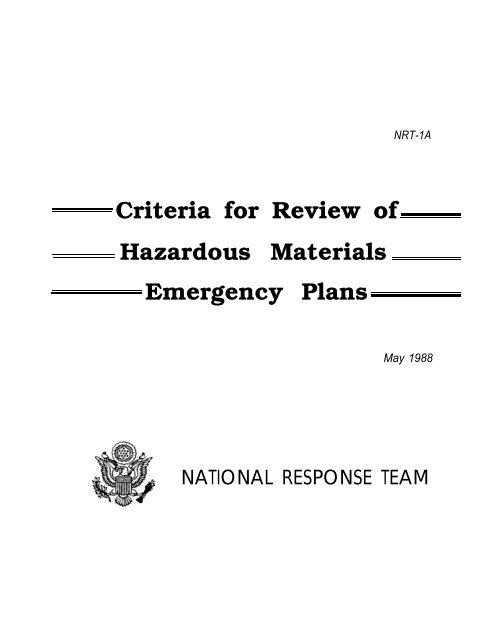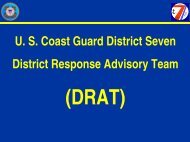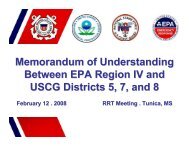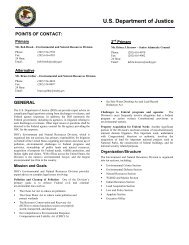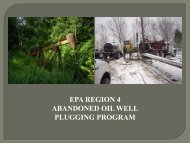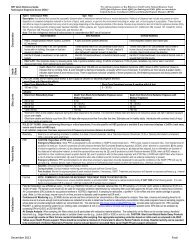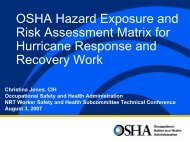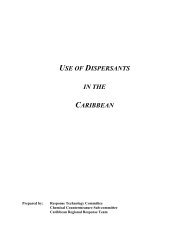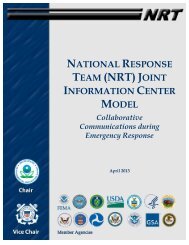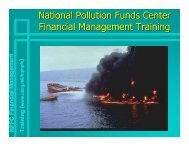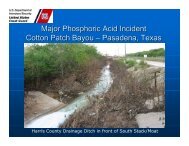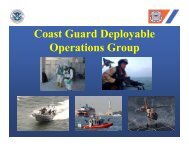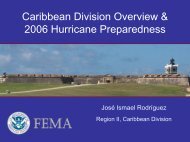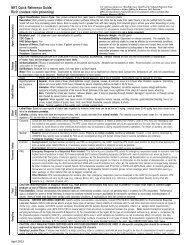Criteria for Review of Hazardous Materials Emergency Plans
Criteria for Review of Hazardous Materials Emergency Plans
Criteria for Review of Hazardous Materials Emergency Plans
You also want an ePaper? Increase the reach of your titles
YUMPU automatically turns print PDFs into web optimized ePapers that Google loves.
NRT-1A<strong>Criteria</strong> <strong>for</strong> <strong>Review</strong> <strong>of</strong><strong>Hazardous</strong> <strong>Materials</strong><strong>Emergency</strong> <strong>Plans</strong>May 1988NATIONAL RESPONSE TEAM
National Response Team<strong>of</strong> the National Oil and <strong>Hazardous</strong>Substances Contingency PlanG-WER/12, 2100 2nd Street SW, Washington, DC 20593May1988NRTEnvironmentalProtectionAgencyUnited StatesCoast GuardDepartment <strong>of</strong>CommerceDepartment <strong>of</strong>InteriorDepartment <strong>of</strong>AgricultureDepartment <strong>of</strong>DefenseDepartment <strong>of</strong>stateDepartment <strong>of</strong>JusticeDepartment <strong>of</strong>TransportationDepartment <strong>of</strong>Health andHuman ServicesFederal<strong>Emergency</strong>ManagementAgencyDepartment <strong>of</strong>EnergyDepartment <strong>of</strong>LaborThis document transmits the National Response Team's recommendedcriteria <strong>for</strong> reviewing emergency plans submitted to Regional ResponseTeams (RRTs) under the provisions <strong>of</strong> Section 303(g) <strong>of</strong> the <strong>Emergency</strong>Planning and Community Right to Know Act <strong>of</strong> 1986 ( SARA Title III).The criteria <strong>for</strong> <strong>Review</strong> <strong>of</strong> <strong>Hazardous</strong> <strong>Materials</strong> <strong>Emergency</strong> <strong>Plans</strong> are toserve as a supplement to the National Response Team's <strong>Hazardous</strong> <strong>Materials</strong><strong>Emergency</strong> Planning Guide (NRT-1) published in March 1987. In additionto their use by the RRTs, the criteria also can be useful to State<strong>Emergency</strong> Response Commissions (SERCs) and Local <strong>Emergency</strong> PlanningCommittees (LEPCs) in the development and review <strong>of</strong> plans.The National Response Team suggests the following <strong>for</strong> RRT reviews:(1) Local plans should be submitted to the RRT through the appropriateState <strong>Emergency</strong> Response Commissions (SERC) after the SERCs have completedtheir own review: (2) Regional Response Team plan review should focusprimarily on plans prepared <strong>for</strong> designated priority areas within eachState, i.e. those areas where there are concentrations <strong>of</strong> hazardoussubstances manufacturing, storage, or transportation facilities thatpose substantial hazards to the public health and safety, and shouldensure consistency between those local plans and the relevant Federalplans: and (3) Regional Response Teams should use the review and commentprocess as a <strong>for</strong>m <strong>of</strong> technical assistance to SERCs and LEPCs. The reviewsdo not constitute <strong>for</strong>mal approval or disapproval.For further in<strong>for</strong>mation concerning Regional Response Team reviews,please contact:Boston, MA (I)617-860-4300New York, NY (II)and Caribbean201-548-8730Chicago, IL (V)312-353-2318Dallas, TX (VI)214-655-6444Philadelphia, PA (III) Kansas City, KS (VII)215-597-9800 913-236-3888Denver, CD (VIII)303-293-1723San Francisco, CA (IX)and the Pacific Basin Region415-974-7511Seattle, WA (X)206-442-1196Anchorage, AK907-271-5083Vice ChairmanNational Response TeamReport Oil and Chemical Spills Toll Free (800)424-8802
TABLE OF CONTENTSINTRODUCTION . . . . . . . . . . . . . . . . . . . . . . . . 1BACKGROUND . . . . . . . . . . . . . . . . . . . . . . . . . 1BASIS FOR THE CRITERIA . . . . . . . . . . . . . . . . . . . 3USE OF CRITERIA . . . . . . . . . . . . . . . . . . . . . . 4RRT CONSIDERATION OF THE LEPC PLANNING PROCESS . . . . . . . 4CRITERIA FOR PLANS ..................... 6Incident In<strong>for</strong>mation Summary ............. 6Promulgation Document ................. 6Legal Authority and Responsibility <strong>for</strong> Response .... 7Table <strong>of</strong> Contents ................... 7Abbreviations and Definitions ............. 7Planning Factors ................... 8Concept <strong>of</strong> Operations ................. 10Instructions <strong>for</strong> Plan Use ............... 12<strong>Emergency</strong> Notification Procedures ........... 12Initial Notification <strong>of</strong> Response Agencies ....... 14Direction and Control ................. 15Communication Among Responders ............ 16Warning Systems and <strong>Emergency</strong> Public Notification ... 17Public In<strong>for</strong>mation and Community Relations ...... 18Resource Management .................. 19Health and Medical .................. 20Response Personnel Safety ............... 21Personal Protection <strong>of</strong> Citizens/Indoor Protection ... 22Personal Protective Measures/Evacuation Procedures . . 23Fire and Rescue .................... 25Law En<strong>for</strong>cement .................... 26On-Going Incident Assessment ............. 26Human Services .................... 27Public Works ..................... 27Techniques <strong>for</strong> Spill Containment and Cleanup ..... 28Documentation and Investigative Follow-up ....... 29Procudures <strong>for</strong> Testing and Updating the Plan. ..... 29Training ....................... 30
CRITERIA FOR REVEIW OF HAZARDOUS MATERIALS EMERGENCY PLANSINTRODUCTIONThis document contains a set <strong>of</strong> criteria which may be used by theRegional Response Teams (RRTs) in the review <strong>of</strong> local plans underthe provisions <strong>of</strong> Section 303(g) <strong>of</strong> the Superfund Amendments andReauthorization Act <strong>of</strong> 1986 (SARA). These criteria also may beused by local emergency planning committees (LEPCs) <strong>for</strong> preparingplans as required under Section 303(a) and by state emergencyresponse commissions (SERCs) <strong>for</strong> reviewing plans as requiredunder Section 303(e) <strong>of</strong> the Act. This review guide is intendedas a companion document to the <strong>Hazardous</strong> <strong>Materials</strong> <strong>Emergency</strong>Planning Guide (NRT-l), and can be viewed as a supplement to theplanning process as implemented by local emergency planningcommittees.BACKGROUNDSection 303(a) <strong>of</strong> the Superfund Amendments and ReauthorizationAct <strong>of</strong> 1986 requires each local emergency planning committee toprepare comprehensive hazardous substances emergency responseplans by October, 1988. The local emergency planning committeeis required to review the plan once a year, or more frequently aschanged circumstances in the community or at any facility mayrequire.Section 303(b) requires each local emergency planning committeeto evaluate the need <strong>for</strong> resources necessary to develop,implement, and exercise the emergency plan, and to makerecommendations with respect to additional resources that may berequired and the means <strong>for</strong> providing these additional resources.Section 303(c) specifically states that "Each emergencymanagement plan shall include (but is not limited to) each <strong>of</strong> thefollowing:(1) Identification <strong>of</strong> facilities subject to therequirements <strong>of</strong> this subtitle that are within theemergency planning district, identification <strong>of</strong>routes likely to be used <strong>for</strong> the transportation <strong>of</strong>substances on the list <strong>of</strong> extremely hazardoussubstances referred to in Section 302(a), andidentification <strong>of</strong> additional facilitiescontributing or subjected to additional risk dueto their proximity to facilities subject to therequirements <strong>of</strong> this subtitle, such as hospitalsor natural gas facilities.1
(2)(3)(4)(5)(6)(7)(8)(9)Methods and procedures to be followed by facilityowners and operators and local emergency andmedical personnel to respond to any release <strong>of</strong>such substances.Designation <strong>of</strong> a community emergency coordinatorand facility emergency coordinators, who shallmake determinations necessary to implement theplan.Procedures providing reliable, effective, andtimely notification by the facility emergencycoordinators and the community emergencycoordinator to persons designated in theemergency plan, and to the public, that a releasehas occurred (consistent with the emergencynotification requirements <strong>of</strong> Section 304).Methods <strong>for</strong> determining the occurrence <strong>of</strong> arelease, and the area or population likely to beaffected by such release.A description <strong>of</strong> emergency equipment andfacilities in the community and at each facilityin the community subject to the requirements <strong>of</strong>this subtitle, and an identification <strong>of</strong> thepersons responsible <strong>for</strong> such equipment andfacilities.Evacuation plans, including provisions <strong>for</strong> aprecautionary evacuation and alternative trafficroutes.Training programs, including schedules <strong>for</strong>training <strong>of</strong> local emergency response and medicalpersonnel.Methods and schedules <strong>for</strong> exercising the emergencyplan."Under Section 303(e) <strong>of</strong> the Act, state emergency responsecommissions are required to review and make recommendations oneach plan to ensure "coordination" with the plans <strong>of</strong> other localemergency planning districts.Under Section 303(g) <strong>of</strong> the Act, the Regional Response Teams "mayreview and comment upon an emergency plan or other issues relatedto preparation, implementation, or exercise <strong>of</strong> such a plan uponrequest <strong>of</strong> a local emergency planning committee." This review isviewed by the National Response Team to be a <strong>for</strong>m <strong>of</strong> technicalassistance to the local emergency planning committees and the2
state emergency response commissions, and is not to be consideredas an approval <strong>of</strong> these plans.Finally, under Section 303(f), the National Response Team isrequired to issue guidance documents <strong>for</strong> the preparation andimplementation <strong>of</strong> emergency plans. In March, 1987 the NationalResponse Team published and distributed the first such guidancedocument by issuing NRT-1, the <strong>Hazardous</strong> <strong>Materials</strong> <strong>Emergency</strong>Planning Guide. NRT-1 contains extensive discussion <strong>of</strong> both theplanning process and the elements or contents required <strong>for</strong> aneffective hazardous materials emergency response plan. Thefollowing plan review criteria are issued as supplementaltechnical guidance to NRT-1.BASIS FOR THE CRITERIAThe review criteria are based on the guidelines <strong>for</strong> plans ascontained in Section 303(c) <strong>of</strong> the Act, NRT-1, and CPG l-8, Guide<strong>for</strong> Development <strong>of</strong> State and Local <strong>Emergency</strong> Onerations <strong>Plans</strong>,published by the Federal <strong>Emergency</strong> Management Agency. Section303(c) outlines the minimum requirements <strong>for</strong> local emergencyresponse plans. The criteria which address these minimumrequirements are introduced throughout the document by thephrase "the plan shall." The criteria based upon NRT-1, whichexpand upon the above minimum requirements, include all theelements that the NRT considers essential <strong>for</strong> an effectivehazardous materials emergency response plan. While localemergency planning committee plans are not required to containall these elements, the NRT believes that they should.Accordingly, the criteria based on the planning elements in NRT-1(and many <strong>of</strong> the elements in CPG l-8) are introduced by thephrase "the plan should." In those cases where a plan may beimproved by including other considerations, the criteria areintroduced by the phrase "the plan might." In these cases, thecriteria are not recommended either by Title III, NRT-1, or CPGl-8.There also are criteria included in this document that areconsidered to be <strong>of</strong> such merit that they are placed under thecategory "the plan should", but cannot be specifically cited fromTitle III, NRT-1, or CPG 1-8.subsequent revisions to NRT-1 anddocument with an asterisk (*).These criteria will be included inare highlighted in thisCPG l-8 (used as one <strong>of</strong> the sources <strong>for</strong> these criteria) is usedby local governments to develop emergency operations plans whichare required by the Comprehensive Cooperative Agreements betweenthe Federal <strong>Emergency</strong> Management Agency and the states. CPG l-8a Guide <strong>for</strong> the <strong>Review</strong> <strong>of</strong> State and Local <strong>Emergency</strong> Operations<strong>Plans</strong>, also was used as a resource <strong>for</strong> developing these reviewcriteria. The planning elements in CPG l-8 have been3
incorporated into NRT-1, and most <strong>of</strong> the review criteria in CPGl-8a are included in the attached RRT Plan <strong>Review</strong> Document. Therelevant sections <strong>of</strong> Title III, NRT-1, and CPG l-8 are indexed inthe review document <strong>for</strong> in<strong>for</strong>mational purposes.The plan criteria outlined below are structured to correspond tothe sequence <strong>of</strong> plan elements suggested by Chapters 4 through 6<strong>of</strong> NRT-1 and Chapters 2 and 3 <strong>of</strong> CPG l-8.USE OF CRITERIAThe NRT expects that the primary use <strong>of</strong> these criteria will be inplan review by Regional Response Teams. Through the use <strong>of</strong> thesecriteria and the development <strong>of</strong> comments related thereto, theRRTs can both conduct organized and systematic reviews <strong>of</strong> localplans and ensure that plan elements <strong>of</strong> particular interest toRRTs are covered. The RRTs should also use the criteria as abasis <strong>for</strong> ensuring coordination between federal plans developedunder the National Contingency Plan (e.g., Regional Contingency<strong>Plans</strong> and OSC <strong>Plans</strong>) and plans developed at the local level.As mentioned above, the local emergency planning committees mayfind the criteria useful in the development <strong>of</strong> plans requiredunder Section 303(c) <strong>of</strong> the Act. These criteria are concisestatements <strong>of</strong> the contents <strong>of</strong> plan elements covered in NRT-1 andCPG l-8, and all <strong>of</strong> the plan elements required in Section 303(c).It is essential, however, that the criteria be used by localemergency planning committees only in concert with the full range<strong>of</strong> available guidance.State emergency response commissions may find the plan criteriauseful in the coordination <strong>of</strong> local emergency planning committeesand in the review <strong>of</strong> each local plan. The criteria <strong>of</strong>fer a usefulguide <strong>for</strong> all <strong>of</strong> the planning elements which may requirecoordinated and consistent treatment among the local emergencyplanning committees within a state. They also provide the basis<strong>for</strong> a more general review <strong>of</strong> plans.RRT CONSIDERATION OF THE LEPC PLANNING PROCESSOne <strong>of</strong> the major themes <strong>of</strong> NRT-1 is that the way in which a localhazardous materials emergency plan is developed is as importantas the actual contents <strong>of</strong> such a plan. Thus, the RegionalResponse Teams may find it useful to secure the followingin<strong>for</strong>mation pertaining to the local emergency planning committeeunder review:1. A list <strong>of</strong> the names and affiliations <strong>of</strong> the members <strong>of</strong> theLEPC;4
2. A description <strong>of</strong> the activities and accomplishments (withcompletion dates) <strong>of</strong> the committee in compliance withSection 301, including:Appointment <strong>of</strong> a chairperson;Establishment <strong>of</strong> rules <strong>for</strong> committee operations;Development <strong>of</strong> methods <strong>for</strong> public notification <strong>of</strong>committee activities:Conduct <strong>of</strong> public meetings on the emergency plan;Receiving and responding to public comments: andPublic notice <strong>of</strong> availability <strong>of</strong> emergency responseplan, Material Safety Data Sheets, and inventory <strong>for</strong>msunder Section 324;Dealing with public requests <strong>for</strong> in<strong>for</strong>mation underSections 311, 312 and 313; andSecuringplan.in<strong>for</strong>mation from facilities covered by the3. A description <strong>of</strong> the major activities <strong>of</strong> the committee incompleting the tasks <strong>for</strong> the hazard analysis and capabilityassessment.4. A summary <strong>of</strong> the data produced by these tasks, if notalready described in the plan.5. A summary <strong>of</strong> the resources expended in developing the plan,including local funds, staff ef<strong>for</strong>t and technical expertise,plus a summary <strong>of</strong> resources required <strong>for</strong> maintaining andrevising the plan.6. A description <strong>of</strong> any findings on ways to fund hazardousmaterials emergency planning within the district.5
CRITERIA FOR PLANS1.0 INCIDENT INFORMATION SUMMARYThe Plan shoud lcontain:1.1 Detailed description <strong>of</strong> the essentialin<strong>for</strong>mation that is to be developedand recorded by the localresponse system in an actual incident,e.g., date, time, location,type <strong>of</strong> release, and material re-leased;DOCUMENTATIONTITLE III NRT-1 CPG l-8A.12.0 PROMULGATION DOCUMENTThe Plan should contain:2.1 A document signed by the chairperson<strong>of</strong> the LEPC, promulgating the plan<strong>for</strong> the district;2.2 Documents signed by the chief executives<strong>of</strong> all local jurisdictionswithin the district 2 ; andA.2 2.3(a) (1)*1. (a) All criteria with a Title III reference are requested by section303(c) <strong>of</strong> the Act and are introduced by the phrase "The Plan shall."(b) All criteria with an NRT-1 reference are not required by TitleIII, but are regarded as essential by the NRT <strong>for</strong> an effective hazardousmaterials emergency response plan. They can be found in NRT-1, Chapter 5,"Planning Elements", and are introduced by the phrase "The Plan should."(c) All CPG l-8 references include those criteria that address requirements<strong>for</strong> emergency operations plans prepared under the provisions <strong>of</strong>the Comprehensive Cooperative Agreements with the Federal <strong>Emergency</strong> ManagementAgency.2 These criteria are considered to be <strong>of</strong> such merit that they areincluded under the heading The plan should", but cannot specifically becited from Title III, NRT-1, or CPG l-8. They are designated in thedocumentation section by an asterisk (*). They will be included insubsequent revisions to NRT-1.6
CRITERIA FOR PLANS2.3 Letters from affected facilities endorsingthe plan.The Plan might contain:2.4 Letters <strong>of</strong> agreement between theaffected facilities and local jurisdictions<strong>for</strong> emergency response andnotification responsibilities.DOCUMENTATIONTITLE III NRT-1 CPG l-8*A.23.0 LEGAL AUTHORITY AND RESPONSIBILITYFOR RESPONSEThe Plan should:3.1 Describe, reference, or includelegal authorities <strong>of</strong> the jurisdictionswhose emergency response rolesare described in the plan, includingauthorities <strong>of</strong> the emergency planningdistrict and the local jurisdictionswithin the district; and3.2 List all other authorities the LEFCregards essential <strong>for</strong> responsewithin the district, including stateand federal authorities.A.3 2.3(h)II4. TABLE OF CONTENTSThe Plan should:4.1 List all elements <strong>of</strong> the plan, providetabs <strong>for</strong> each and provide across-reference <strong>for</strong> all <strong>of</strong> the ninerequired elements in Section 303 <strong>of</strong>the Act. <strong>Plans</strong> that are prepared inthe context <strong>of</strong> requirements <strong>of</strong> CPGl-8 should contain an index to thelocation <strong>of</strong> both NRT-1 and Section303 elements.A.4 2.3(a) (3)5. ABBREVIATIONS AND DEFINITIONSThe Plan should:7
CRITERIA FOR PLANSDOCUMENTATIONTITLE III NRT-1 CPG l-85.1 Explain all abbreviations and defineall essential terms included in theplan text.A.5 2.3(i)6.0 PLANNING FACTORSAssumption: Assumptions are theadvance judgments concerning whatmight happen in the case <strong>of</strong> an accidentalspill or release.The Plan should:6.1 List all <strong>of</strong> the assumptions aboutconditions that might develop in thedistrict in the event <strong>of</strong> accidentsfrom any <strong>of</strong> the affect& facilitiesor along any <strong>of</strong> the transportationroutes.Planning FactorsThe planning factors consist <strong>of</strong> allthe local conditions that make anemergency plan necessary.The Plan shall:6.2 Identify and describe the facilitiesin the district that possess extremelyhazardous substances and thetransportation routes along whichsuch substances may move within thedistrict:6.3 Identify and describe other facilitiesthat my contribute to additionalrisk by virtue <strong>of</strong> their proximityto the above mentioned facilities:6.4 Identify and describe additionalfacilities included in the plan thatare subject to additional risks dueto their proximity to facilitiesA.6 2.3(c)303(c) (1) A.6 2.3(c)IIII8
CRITERIA FOR PLANSDOCUMENTATIONTITLE III NRT-1 CPG l-8with extremely hazardous substances;and6.5 Include methods <strong>for</strong> determining thata release <strong>of</strong> extremely hazardoussubstances has occurred, and thearea <strong>of</strong> population likely to be affectedby such release.The Plan should:6.6 Include the major findings from thehazard analysis, (date <strong>of</strong> analysisshould be provided) which shouldconsist <strong>of</strong>:6.6.1 Major characteristics <strong>of</strong> affectedfacilities/trasportationroutes impacting on thetypes and levels <strong>of</strong> hazardsposed, including the types,identities, characteristics,and quantities <strong>of</strong> hazardousmaterials related to facilitiesand transportation routes;6.6.2 Potential release situationswith possible consequences beyondthe boundaries <strong>of</strong> facilities,or adjacent to transportationmutes. Use may be made<strong>of</strong> historical data on spillsand any data on spills and anydata secured from facilitiesunder Section 303(d)(3) <strong>of</strong> theAct;6.6.3 Maps showing locations <strong>of</strong> facilities,transportation routes,and special features <strong>of</strong>district, including vulnerableareas;6.7 Geographical features <strong>of</strong> the district,including sensitive environmentalareas, land use patterns,water supplies, and public transportation;9303(c) (5) A.62.3(c)A.6 2.3(a) (4)
CRITERIA FOR PLANSDOCUMENTATIONTITLE III NRT-1 CFG l-86.8 Major demographic features <strong>of</strong> thedistrict, including those featuresthat impact most on emergency responsee.g., population densityspecial populations, and particularlysensitive institutions;6.9 The district's climate and weatheras they affect airborne distribution<strong>of</strong> chemicals; and6.10 Critical time variables impacting onemergencies, e.g., time <strong>of</strong> day andmonth <strong>of</strong> year in which they wouldbe most likely occur.A.6 2.3(a) (4)7.0 CONCEPT OF OPERATIONSThe Plan shall:7.1 Designate a emergency co- 303(c) (3)ordinator and facility emergencycoordinators, who shall make determinationsnecessary to implement theplan.The Plan should:7.2 Identify, by title, the individualdesignated as the community emergencycoordinator and each <strong>of</strong> the facilityemergency coordinators;7.37.4Explain the relationships betweenthese coordinators, their organizations,and the other local governmentalresponse authorities withinthe district, e.g., the county emergencymanagement authority;Describe the relationship betweenthis plan and other response planswithin the district which deal inwhole or in part with hazardousmaterials emergency response, e.g.the county <strong>Emergency</strong> Operations Plan10A.7bA.7c2.3(d)
CRITERIA FOR PLANSDOCUMENTATIONTITLE III NRT-1 CPG 1-8and plans developed by fire departmentsunder OSHA Regulation CFR 29Part 1910-120;7.5 List all the facility emergencyplans within the district that applyto hazardous materials emergency response,including all plans developedunder OSHA Regulation on <strong>Hazardous</strong>Waste Operations and <strong>Emergency</strong>Response (CFR 29 CFR Part 1910.120);7.6 Describe the way in which the aboveplans are integrated with local responseplans:7.7 Describe the functions and responsibilities<strong>of</strong> all the local responseorganizations within the district,including public and private sectoras well as volunteer and charitableorganizations;7.8 List mutual aid agreement or otherarrangements <strong>for</strong> sharing data andresponse;7.9 Describe conditions tier which thelocal government will coordinate itsresponse with other districts andthe means or sequence <strong>of</strong> activitiesto be followed by districts in interactingwith other districts;7.10 Describe the relationship betweenplans <strong>of</strong> the district and relatedstate plans;7.11 Describe the relationship betweenlocal and state emergency responseauthorities: and7.12 Describe the relationships betweenemergency response plans and activitiesin the district and responseplans and activities by federalagencies, including all plans andA.7cA.7bA.3A.7bA.7cA.7bA.7b;A.7c2.3 (e)11
CRITERIA FOR PLANSDOCUMENTATIONTITLE III NRT-1 CPG l-8responses outlined in the NationalContingency Plan.[Emphasis should be given to theallocation <strong>of</strong> responsibilities amongfederal emergency response agencies,including listing the names and theresponsibilities <strong>of</strong> federal responseagencies and entities such as theRRT, describing the means <strong>for</strong> theirnotification, the types <strong>of</strong> resourcesto be sought from them, the mans<strong>for</strong> obtaining them, the conditionsunder which assistance is to be provided,and the methods <strong>of</strong> coordinationduring a response]8. INSTRUCTIONS FOR PLAN USEThe Plan should:8.1 Contain a discussion <strong>of</strong> the purpose<strong>of</strong> the plan; and8.2 Contain a list <strong>of</strong> organizations andpersons receiving the plan or planamendments and the date that theplan was transmitted as well as aspecific identification number <strong>for</strong>each plan.A.8aA.8b2.3(a) (5) (b)2.3(a) (5) (c)9.09.1RECORD OF AMENDMENTSThe Plan should:Contain a section that describesmethods <strong>for</strong> maintaining and revisingthe plan and recording all changesin the plan, including a method <strong>for</strong>controlling distribution.A.9 2.3 (a) (6)10.0 EMERGENCY NOTIFICATION PROCEDURESThe Plan shall:12
CRITERIA FOR PLANSDOCUMENTATIONTITLE III NRT-1 CPG l-810.1 Include procedures <strong>for</strong> providingreliable, effective, and timely notificationby the facility emergencycoordinators and the community emergencycoordinator to persons designatedin the emergency plan, and tothe public, that a release has303(c)(4) c.43.3(c)The Plan should:10.2 Include procedures <strong>for</strong> immediatelynotifying the appropriate 24-hourhotline first, and should locatetheseprocedures in a prominentplace in the plan:10.3 List the 24-hour emergency hotlinenumber(s) <strong>for</strong> the local emergencyresponse organization(s) within thedistrict;10.4 Contain an accurate and up to date<strong>Emergency</strong> Assistance Telephone Rosterthat includes numbers <strong>for</strong> the:10.4.1 Technical and response personnel;10.4.2 Community emergency coordinator,and all facility emergencycoordinators;10.4.3 CHEMTREC;10.4.4 National Response Center; 310.4.5 Other participating agencies:10.4.6 Community emergency coordinatorsin neighboring emergencyplanning districts;C.lB*3 Spills exceeding the CERCLA reportable quantities are requiredto be reported to the National Response Center.13
CRITERIA FOR PLANS10.4.7 Public and private sector supportgroups; and the10.4.8 Points <strong>of</strong> contact <strong>for</strong> all majorcarriers on transportation routeswithin the district;10.5 List all local organizations to benotified <strong>of</strong> a release, and the order<strong>of</strong> their notification, and listnames and telephone numbers <strong>of</strong> primanyand alternate points <strong>of</strong> contact:10.6 List all local institutions to benotified <strong>of</strong> the occurrence <strong>of</strong> a releaseand the order <strong>of</strong> their notification,and the names and telephonenumbers<strong>of</strong> contacts;10.7 List all state organizations to benotified, and list the names andtelephone numbers <strong>of</strong> contacts: and10.8 List all federal response organizationsto be notified, and the namesand telephones nmbers <strong>of</strong> the contacts.DOCUMENTATIONTITLE III NRT-1 CFG l-8B***11.0 INITIAL NOTIFICATION OF RESPONSEAGENCYThe plan should:11.1 Describe methods or means to be usedby facility emergency coordinators(FECs) within the district to notifycommunity emergency coordinators(CECs) <strong>of</strong> any potentially affecteddistricts, and SERCs <strong>of</strong> any potentiallyaffected states, and myother persons to whom the facilityis to give notification <strong>of</strong> any releastin compliance with Section304 <strong>of</strong> Title III;11.2 Describe methods by which the CECsand local response organizations14C.l
CRITERIA FOR PLANSDOCUMENTATIONTITLE III NRT-1 CPG 1-8will be notified <strong>of</strong> releases fromtransportation accidents, followingnotification through 911 system orspecified alternative means:11.3 Describe methods by which the CEC,or his designated agent, will ensurethat contents <strong>of</strong> notification matchthe requirements <strong>of</strong> Section 304,including the regulations containedin 40 CFR Part 355 (Notification Requirments,Final Rule);11.4 List procedures by which the CECwill assure that both the immediateand follow-on notifications fromfacility operators are made withinthe time frames specified by Notification<strong>of</strong> Final Rule in 40 CFRPart 355; and11.5 Identify the person or <strong>of</strong>fice responsible<strong>for</strong> receiving the notification<strong>for</strong> the community emergencycoordinator or his/her designatedagent and list the telephone number;C.112.0 DIRECTION AND CONTROLThe Plan shall:12.1 Include methods and procedures to befollowed by facility owners and operatorsand local emergency and medicalpersonnel to respond to arelease<strong>of</strong> extremely hazardous substances.303 (c) (2)The Plan should:12.2 Identify the organization within thedistrict responsible <strong>for</strong> providingdirection and control to the overallemergency response system describedin the Concept <strong>of</strong> operations;C.2 3.3(a)15
CRITERIA FOR PLANS12.3 Identify persons or <strong>of</strong>fices withineach response organization who providedirection and control to each<strong>of</strong> the organizations;DOCUMENTATIONTITLE III NRT-1 CPG l-8C.2 3.3(a)12.4 Identify persons or <strong>of</strong>fices providingdirection and control withineach <strong>of</strong> the emergency response function;12.5 Describe persons or <strong>of</strong>fices responsible<strong>for</strong> the per<strong>for</strong>mance <strong>of</strong> incidentcommand functions and the wayin which the incident command systemis used in hazardous substancesincidents:12.6 Describe the chain <strong>of</strong> command <strong>for</strong>the total response system, <strong>for</strong> each<strong>of</strong> the major response functions and<strong>for</strong> the organization controlled bythe incident commander; and12.7 Identify persons responsible <strong>for</strong>the activation and operations <strong>of</strong> theemergency operations center, the onscenecommand post, and the methodsby which they will coordinate theiractivities:12.8 List three levels <strong>of</strong> incident severityand associated response levels;12.9 Identify the conditions <strong>for</strong> eachlevel: and12.10 Indicate the responsible organizationsat each level.13.0 COMMUNICATION AMONG RESPONDERSThe Plan should:13.1 Describe all the methods by whichidentified responders will exchangein<strong>for</strong>mation and communicate witheach other during a response, in-C.3 3.3(b)16
CRITERIA FOR PLANSDOCUMENTATIONTITLE III NRT-1 CPG l-8cluding the commmications networksand common frequencies to be used;[At a minimum, these methods shouldbe described <strong>for</strong> each function. Bothcommunications among local responseunits and between these units andfacilities where incidents occurshould be described]13.2 Describe the methods by which emergencyresponders can receive in<strong>for</strong>mationon chemical and relatedresponse measure; and[May include a description <strong>of</strong> computersystems with on line databases]13.3 Describe primary and back-up system<strong>for</strong> all comunication channels andsystems.The Plan might:13.4 contain a diagram or matrix showingthe flaws <strong>of</strong> in<strong>for</strong>mation within theresponse system.C.3* 3.3(b)14.0 WARNING SYSTEM AND EMERGENCY PUBLICNOTIFICATIONThe Plan should:14.1 Identify responsible <strong>of</strong>ficials withinthe district and describe themethods by which they will notifythe public <strong>of</strong> a release from anyfacility or along any transportationroute, including sirens or othersignals, and use <strong>of</strong> the broadcastmedia and the <strong>Emergency</strong> BroadcastSystem. This should include a description<strong>of</strong>:14.1.1 The sirens and other signals tobe employed, their meaning,their methods <strong>of</strong> coordination,17C.4 3.3(c)
CRITERIA FOR PLANSand their geographical coverage:14.1.2 Other methods, such as door-todooralerting, that my beenployed to reach segments <strong>of</strong>the population that may not bereached by sirens or other signals:and14.1.3 Time frames within which notificationto the public can beaccomplished;14.2 Describe methods <strong>for</strong> the coordination<strong>of</strong> emergency public notificationduring a response; and14.3 Describe any responsibilities oractivities <strong>of</strong> facilities covered bythe Act <strong>for</strong> emergency public notificationduring a response.DOCUMENTATIONTITLE III NRT-1 CPG l-8C.4 3.3(c)15. PUBLIC INFORMATION AND COMMUNITYRELATIONSThe Plan should:15.l Describe the methods used by localgovernments, prior to emergencies,<strong>for</strong> educating the public about possibleemergencies and planned protectivemeasures;15.2 Describe the role and organizationalposition <strong>of</strong> the public in<strong>for</strong>mation<strong>of</strong>ficer during emergencies;15.3 Designate a spokesperson and describethe methods <strong>for</strong> keeping thepublic in<strong>for</strong>med during an emergencysituation, including a list <strong>of</strong> allradio, TV, and press contacts; and15.4 Describe any related public in<strong>for</strong>mationactivities <strong>of</strong> affected faci-C.5 3.3(d)*18
CRITERIA FOR PLANSDOCUMENTATIONTITLE III NRT-1 CPG 1-8lities, both prior to an emergencyand during an emergency.16.0 RESOURCE MANAGEMENTThe Plan shall:16.1 Include a description <strong>of</strong> emergencyequipment and facilities in the communityand at each facility in thecommunity subject to the requirements<strong>of</strong> this subtitle and an identification<strong>of</strong> the persons responsible<strong>for</strong> such equipment and facilities.303(c) (6)The Plan should:16.2 List personnel resources available<strong>for</strong> emergency response by major categories,including governmental,volunteer, and the private sector;16.3 Describe the types, quantities, capabilitiesand locations <strong>of</strong> emergencyresponse equipment available to thelocal emergency response units, includingfire, police and emergencymedical response units.[Categories <strong>of</strong> equipment should includetransportation, communications,monitoring and detection,containment decontamination, removal,and cleanup]16.4 List the emergency response quipmentavailable to each <strong>of</strong> the affectedfacilities and describe themin the same way as community equipmentis described;16.5 Describe the emergency operatingcenters or other facilities availableto the local community and thefacility emergency coordinators andother response coordinators, such asincident commanders;C.6 3.3(n)19
CRITERIA FOR PLANSDOCUMENTATIONTITLE III NRT-1 CPG l-816.6 Describe emergency response equipmentand facilities available toeach affected facility and the conditionsunder which the are to beuse support <strong>of</strong> local reponders;16.7 Describe significant resource shortfallsand mutual support agreementswith other jurisdictions where by thedistrict might increase its capabilitiesin an emergency;[This my be discussedConcept <strong>of</strong> Operations]under the16.8 Describe procedures <strong>for</strong> securingassistance from federal and stateagencies and their emergency supportcontractors;[This may be discussed under theConcept <strong>of</strong> Operations]16.9 Describe emergency response capabilitiesand the expertise in theprivate sector that might be availableto assist local responders,facility managers, and transportationcompanies during emergencies.C.6 3.3(n)II17.0 HEALTH AND MEDICALThe Plan shall:17.1Include methods and procedures to befollowed by facility owners and operatorsand local emergency and medicalpersonnel to respond to a release<strong>of</strong> extremely hazardous substances.The Plan should:17.2 Describe the procedures <strong>for</strong> summoningemergency medical and healthdepartment personnel;20303(c) (2)C.7 3.3(h)
CRITERIA FOR PLANSDOCUMENTATIONTITLE III NRT-1 CPG l-817.317.517.617.717.817.9Describe the procedures <strong>for</strong> themajor types <strong>of</strong> emergency medicalservices, including first aid, triage,ambulance service, and emergencymedical care, using both theresources available within the districtand those that can be securedin neighboring districts;17.4 Describe the procedures to be followed<strong>for</strong> decontamination <strong>of</strong> exposedpeople:Describe the procedures <strong>for</strong> providingsanitation, food, water supplies,and safe re-entry <strong>of</strong> personsto the accident area;Describe procedures <strong>for</strong> conductinghealth assessments upon which tobase protective action decisions;Describe the level and types <strong>of</strong>emergency medical capabilities inthe district to deal with exposure<strong>of</strong> people to extremely hazardoussubstances;Describe the provisions <strong>for</strong> emergencymental health care; andIndicate mutual aid agreement withother communities to provide backupemergency medical and health departmentpersonnel, and equipment.C.7 3.3(h)*C.718.018.1RESPONSE PERSONNEL SAFETYThe Plan should:Describe initial and follow-up procedures<strong>for</strong> entering and leavingincident sites, including personnelaccount ability personnel safety precautions,and medical monitoring:21C.8
CRITERIA FOR PLANS18.2 Describe personnel and equipmentdecontamination procedures; andDOCUMENTATIONTITLE III NRT-1 CPG l-8C.818.3 List sampling, monitoring and personnelprotective equipment appropriateto various degrees <strong>of</strong> hazardsbased on EPA levels <strong>of</strong> protection(A, B, C, & D).[Just prior to publication <strong>of</strong> NRT-1,the Occupational Safety and HealthAdministration (OSHA) published proposedrules (29 CFR Fart 1910.120)to provide more definitive requirementsto plan <strong>for</strong> emergency responsepersonnel safety. If the LEPC plansinclude a section on this function,the plan elements listed in the OHSAregulation should be used]19.0PERSONAL PROTECTION OF CITIZENS/IN-DOOR PROTECTIONThe Plan shall:19.1Describe methods in place in thecommunity and in each <strong>of</strong> the affectedfacilities <strong>for</strong> determining theareas likely to be affected by arelease.303(c) (5)The Plan should:19.2Include methods to predict the speed,direction, and concentration <strong>of</strong>plumes resulting from airborne releases,and methods <strong>for</strong> modelingvapor cloud dispersion as well asmethods to monitor the release andconcentrations in realtime:C.9a3.3(g)[19.1 and 19.2 may be considered inthe hazard analysis, included inSection 6, Planning Factors]19.3 Identify the decision making pro-22
CRITERIA FOR PLANSDOCUMENTATIONTITLE III NRT-1 CPG 1-8cess, including the decision makingauthority <strong>for</strong> indoor protection:19.4 Describe the roles and activities <strong>of</strong>affected facilities in the decisionmaking <strong>for</strong> indoor protection decisions,including the determinationthat indoor sheltering is no longerrequired:19.5 Indicate the conditions under whichindoor protection would be recommended,including the decision makingcriteria;19.6 Describe the methods <strong>for</strong> indoor protectionthat would be recommended<strong>for</strong> citizens, including provisions<strong>for</strong> shutting <strong>of</strong>f ventilation systems;and19.7 Describe the methods <strong>for</strong> educatingthe public on indoor protective masures;[May be discussed in the section onpublic in<strong>for</strong>mation]C.9aC.9a3.3 (g)20.0 PERSONAL PROTECTIVE MEASURES / EVAC-UATION PROCEDURESThe Plan shall:20.1 Describe evacuation plans, includingthose <strong>for</strong> precautionary evacuationsand alternative traffic routes;The Plan should:20.2 Describe the authority <strong>for</strong> orderingor recommending evacuation, includingthe personnel authorized torecommend evacuation:20.3 Describe the authority and responsibility<strong>of</strong> various governmentalagencies and supporting private sec-23303(c) (7) C.9b 3.3(e)
CRITERIA FOR PLANStor organizations, such as the RedCross, and the chain <strong>of</strong> commandamong them;20.4 Describe the role <strong>of</strong> the affectedfacilities in the evacuation decision-making:20.5 Describe methods to be used in evacuation,including methods <strong>for</strong> assistirgthe movement <strong>of</strong> mobilityimpaired persons and in the evacuation<strong>of</strong> schools, hospitals, prisonsand other facilities;20.6 Describe the relationship <strong>of</strong> evacuationprocedures to other protectivemeasures.20.7 Describe potential conditions requiringevacuation, i.e., the types<strong>of</strong> accidental releases and spillsthat may require evacuation:20.8 Describe evacuation routes, includingprimary and alternative routes;[These may be either establishedroutes <strong>for</strong> the community or specialroutes appropriate to the location<strong>of</strong> facilities]20.9 Describe evacuation zones and distancesand the basis <strong>for</strong> their determination;[These should be related to the location<strong>of</strong> facilities and transportationroutes and the potential pathways<strong>of</strong> exposure]20.10 Describe procedures <strong>for</strong> precautionaryevacuations <strong>of</strong> special populations;20.11 List the mass care facilities <strong>for</strong>providing food, shelter and medicalcare to relocated populations;24DOCUMENTATIONTITLE III NRT-1 CPG l-8*C.9b*C.9b" 3.3(e)II
CRITERIA FOR PLANSDOCUMENTATIONTITLE III NRT-1 CPG l-8[This may be discussed under thehuman services section]20.12 Describe procedures <strong>for</strong> providingsecurity <strong>for</strong> the evacuation, <strong>for</strong>evacuees and <strong>of</strong> the evacuated areas;[May be covered under the law en<strong>for</strong>cementdiscussions]20.13 Describe methods <strong>for</strong> managing theflow <strong>of</strong> traffic along evacuationroutes and <strong>for</strong> keeping the generalpublic from entering threatened areas,including maps with traffic andother control points; and[May be covered in the law en<strong>for</strong>cementsection]20.14 Describe the procedures <strong>for</strong> managingan orderly return <strong>of</strong> people to theevacuated area;C.11 3.3(i)C.9b3.3 (e)21.0 FIRE AND RESCUEThe Plan should:21.1 List the major tasks to be per<strong>for</strong>medby firefighters in copingwith releases <strong>of</strong> extremely hazardoussubstances;C.10 3.3(k)21.2 Identify the public and private sectorfire protection organizationswith a response capability and responsibility<strong>for</strong> hazardous materialsincidents;21.3 Describe the command structure <strong>of</strong>multi-agency, multi-jurisdictionalincident management systems inplace, and identify applicable mutualaid agreements and Good Samaritanprovisions in place;25
CRITERIA FOR PLANS21.4 List available support systems, e.g.protective equipment and emergencyresponse guides, DOT <strong>Emergency</strong> ResponseGuidebook, mutual aid agreements,and good samaritan provisions;and[May be covered under resource management]21.5 List and describe any HAZMAT teamsin the district.[May be covered in Section 21.2above]DOCUMENTATIONTITLE III NRT-1 CPG l-8C.10 3.3(k)*22.0 LAW ENFORCEMENTThe Plan should:22.1 Describe the command structure <strong>of</strong>multi-agency, multi-jurisdictionalincident management systems inplace, and identify applicable mutualaid agreements and Good Samaritanprovisions in place:22.2 List the major law en<strong>for</strong>cementtasks related to respondingto releases<strong>of</strong> extremely hazardous materials,including those related to security<strong>for</strong> the accident site and <strong>for</strong>evacuation activities; and22.3 List the locations <strong>of</strong> control points<strong>for</strong> the per<strong>for</strong>mance <strong>of</strong> tasks, withappropriate maps.C.11 3.3(i)*23.0 ON-GOING INCIDENT ASSESSMENTThe Plan should:23.1 Describe methods in place in thecommunity and/or each <strong>of</strong> the affectedfacilities <strong>for</strong> determining theC.12 3.3(p)26
CRITERIA FOR PLANSareas likely to be affected by anongoing release.23.2 Describe methods <strong>for</strong> determining theprivate and public property that maybe in the affected areas and thenature <strong>of</strong> the impact <strong>of</strong> the releaseon this property;23.3 Describe methods and capabilities <strong>of</strong>both local response organizationsand facilities <strong>for</strong> monitoring thesize, concentration, and migration<strong>of</strong> leaks, spills, and releases, includingsampling around the site:and23.4 Describe provisions <strong>for</strong> enviromentalassessments, biological monitoring,and contamination surveys;DOCUMENTATIONTITLE III NRT-1 CPG l-8C.12 3.3(p)24.0 HUMAN SERVICESThe Plan should:24.1 List the agencies responsible <strong>for</strong>providing emergency human services,e.g., food, shelter, clothing, continuity<strong>of</strong> medical care, and crisiscounseling; andC.13 3.3(m)24.2 Describe the major human servicesactivities and the means <strong>for</strong> theiraccomplishment.25. PUBLIC WORKSThe Plan should:25.1 Describe the chain <strong>of</strong> command <strong>for</strong>the per<strong>for</strong>mance <strong>of</strong> public works actionsin an emergency; and25.2 List all major tasks to be per<strong>for</strong>medby the public works depart-27
CRITERIA FOR PLANSDOCUMENTATIONTITLE III NRT-1 CPG 1-8ment in a hazardous materials incident.26.0 TECHNIQUES FOR SPILL CONTAINMENT ANDCLEANUPThe Plan should:26.1 Explain the allocation <strong>of</strong> responsibilitiesamong local authorities andaffected facilities and responsibleparties <strong>for</strong> these activities;26.2 Describe the major containment andmitigation activities <strong>for</strong> all majortypes <strong>of</strong> HAZMAT incidents:26.3 Describe cleanup and disposal servicesto be provided by the responsibleparties and/or the local community:26.4 Describe major methods <strong>for</strong> cleanup;26.5 Describe methods to restore the surroundingenvironment, including naturalresource areas, to preemergencyconditions;26.6 Describe the provisions <strong>for</strong> longterm site control;26.7 List the location <strong>of</strong> approved disposalsites;26.8 List cleanup material and equipmentavailable within the district;[May be covered in the resourcemanagement section]26.9 Describe the capabilities <strong>of</strong> cleanuppersonne1; and26.10 List the applicable regulationsgoverning disposal <strong>of</strong> hazardousmaterials in the district.D.lD.228
CRITERIA FOR PLANSDOCUMENTATIONTITLE III NRT-1 CPG 1-827. DOCUMENTATION AND INVESTIGATIVEFOLLOW-UPThe Plan should:27.1List all reports required in thedistrict and all <strong>of</strong>fices and agenciesthat are responsible <strong>for</strong> pmparingthem following a release;E27.2 Describe the methods <strong>of</strong> evaluatingresponses and identify persons responsible<strong>for</strong> evaluations; and27.3 Describe provisions <strong>for</strong> cost recovery.28.0 PROCEDURES FOR TESTING AND UPDATINGTHE PLANThe Plan shall:28.1 Include methods and schedules <strong>for</strong>exercising the emergency plan.The Plan should:28.2 Describe the nature <strong>of</strong> the exercises<strong>for</strong> testing the adequacy <strong>of</strong> theplan;28.3 List the frequency <strong>of</strong> such exercises,by type:28.4 Include an exercise schedule <strong>for</strong> thecurrent year and <strong>for</strong> future years;28.5 Describe the role <strong>of</strong> affected facilitiesor transportation companiesin these exercises; and28.6 Describe the procedues by whichper<strong>for</strong>mance will be evaluated in theexercise, revisions will be made to303(c)(9) F.1F.629
CRITERIA FOR PLANSDOCUMENTATIONTITLE III NRT-1 CPG 1-8plans, and deficiencies in responsecapabilities will be corrected.29. TRAININGThe Plan shall:29.1 Include the training programs, includingschedules, <strong>for</strong> training <strong>of</strong>local emergency response and medicalpersonnel.The Plan should:29.2 Describe training requirements <strong>for</strong>LEPC members and all emergencyplanners within the district;29.3 Describe training requirements <strong>for</strong>all major categories <strong>of</strong> hazardousmaterials emergency response personnel,including the types <strong>of</strong>courses and the number <strong>of</strong> hours;29.4 List and describe the training programsto support these requirements,including all training to beprovided by the community, state andfederal agencies, and the privatesector: and29.5 Contain a schedule <strong>of</strong> training activities<strong>for</strong> the current year and<strong>for</strong> the following three years.303(c) (8) 6.4.3**30


